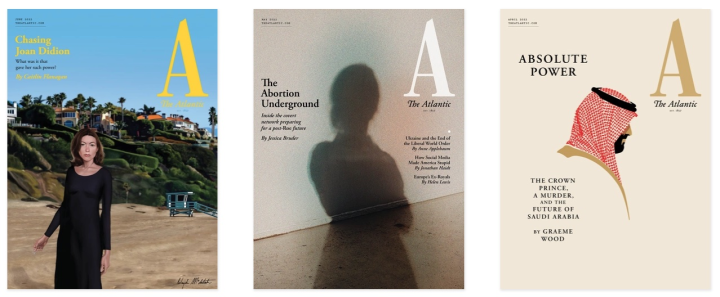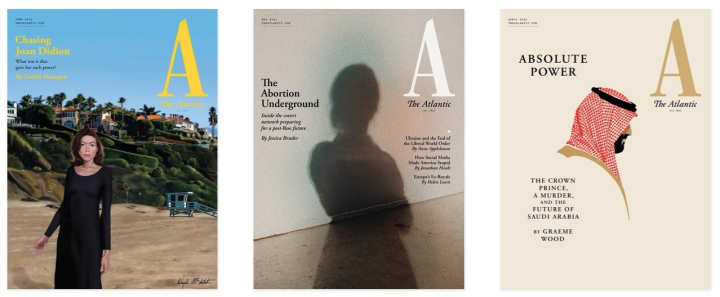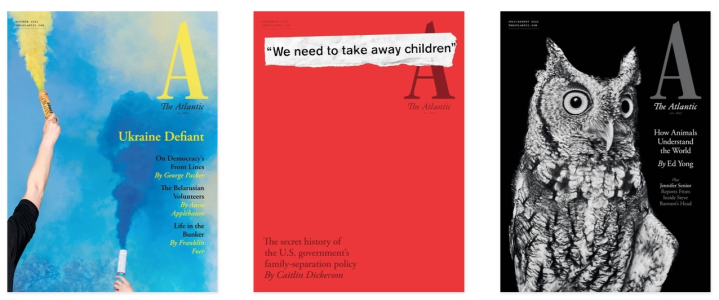
[This fragment is available in an audio version.]
I was cruising through the supermarket when a shopping-cart traffic jam stalled me in front of the “newsstand”. That word is in quotes because most things on offer aren’t news and in fact aren’t magazines in the traditional sense, but single-issue glossies about Princess Diana or Bruce Springsteen or Michelle Obama or Christmas. Anyhow, an awesome cover photo of an owl on the The Atlantic caught my eye; that cover also touted an article about Jack White, whose music I enjoy, so I impulse-bought it. Now I’m thinking about the quality-publishing business model.
· · ·
Recent Atlantic issue covers.
I got a couple hours’ reading pleasure for the handful of bucks I spent on dead trees and ink. Here are some of the advantages of a paper magazine:
It’s as light as any product with “Air” in its name.
You can read it on the bus or in the bath or out in bright sunshine.
The color, resolution, and presentation of images is wonderful. Yes, screens and graphics hardware get better and better, but wow, those pictures on that high-quality paper.
The typography is exquisite. Once again, we make progress on screen presentation, but still.
The pages aren’t visually busy. Yes, there are ads around the edges of some and quite a few odd-numbered pages are full-page ads, once again with fabulous composition and color. But those columns of text, they and their surrounding white space, thoughtfully designed, provide a serene reading experience.
You can fold it up and slip it in a vest pocket. Then you take the folded version out again with one hand and read while you use the other to support yourself on a commuter train.
If you’re operating one-handed you can turn the page by sticking your thumb under the next one and performing a graceful wrist-flip.
The text and images stand still! There are no late-displaying ads or graphics pushing the words around while you’re trying to read them.
Nothing asked me whether it could send notifications.
Nothing suggested that I switch to the app.
In fact: No. Popups. Ever.
Drop it all you want, then step on it even, no biggie. Hell, drive over it too!
No battery, no charger, no wires, no plugs.
The speed at which the text refreshes when you turn the page is remarkable.
There were a few ads suggesting tastefully that I subscribe, but none of the raw sweaty desperation of the contemporary Web.
No venture-capitalist libertarians are being enriched.
When you’re done, you toss it in the recycling bin.
Wait, am I saying that the Web was a mistake, that we should all go back to dead trees? Not at all. I couldn’t tap on the pretty-decent Jack White article and watch a YouTube of the songs. I couldn’t share a particularly tasty written morsel on Twitter. I had to go to a store to get it. I couldn’t read it in bed without turning a lamp on. I probably could have paid for a couple months’ online subscription to The Atlantic for the newsstand price.
But on balance I was left thinking “This feels like a luxury product.” I can’t think of an obvious analogy… Perhaps the enveloping, focusing hands-on experience of putting a record on the turntable as opposed to a streaming service on the earbuds? Except for, magazines are more convenient, once you’ve gone to the trouble of going to the store for them. Hmmm, I hear rumors you can arrange to have them delivered to your home at regular intervals; must check that option out.
I’m thinking purveyors of print ought seriously to consider luxury-product business strategies.
By .
The opinions expressed here
are my own, and no other party
necessarily agrees with them.
A full disclosure of my
professional interests is
on the author page.
如有侵权请联系:admin#unsafe.sh

